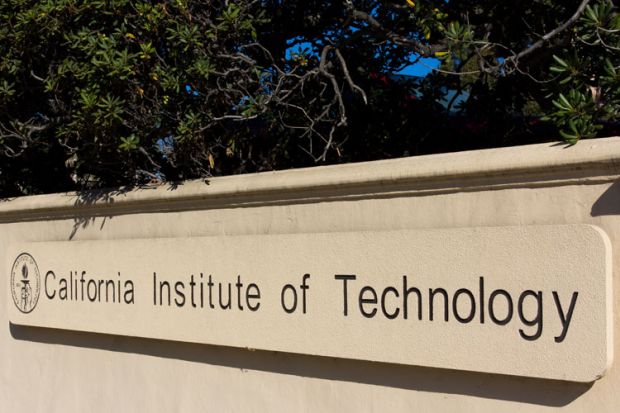Caltech: Finding a Metal-Oxide Needle in a Periodic Table Haystack
Coupling computer automation with an ink-jet printer originally used to print T-shirt designs, researchers at Caltech and Google have developed a high-throughput method of identifying novel materials with interesting properties. In a trial run of the process, they screened hundreds of thousands of possible new materials and discovered one made from cobalt, tantalum, and tin that has tunable transparency and acts as a good catalyst for chemical reactions while remaining stable in strong acid electrolytes.
The effort, described in a scientific article published in Proceedings of the National Academy of Sciences(PNAS), was led by John Gregoire and Joel Haber of Caltech, and Lusann Yang of Google. It builds on research conducted at the Joint Center for Artificial Photosynthesis (JCAP), a Department of Energy (DOE) Energy Innovation Hub at Caltech, and continues with JCAP’s successor, the Liquid Sunlight Alliance (LiSA), a DOE-funded effort that aims to streamline the complicated steps needed to convert sunlight into fuels, to make that process more efficient.
Creating new materials is not as simple as dropping a few different elements into a test tube and shaking it up to see what happens. You need the elements that you combine to bond with each other at the atomic level to create something new and different rather than just a heterogeneous mixture of ingredients. With a nearly infinite number of possible combinations of the various squares on the periodic table, the challenge is knowing which combinations will yield such a material.
“Materials discovery can be a bleak process. If you can’t predict where to find the desired properties, you could spend your entire career mixing random elements and never find anything interesting,” says Gregoire, research professor of applied physics and materials science, researcher at JCAP, and LiSA team lead.
When combining a small number of individual elements, materials scientists can often make predictions about what properties a new material might have based on its constituent parts. However, that process quickly becomes untenable when more complicated mixtures are made.
“Anything more than two elements is considered ‘high dimensional’ in materials science,” Gregoire says. “Most or all of the one- and two-metal oxides are already known,” he says. “The unknown frontier is three or more together.” (Metal oxides are solid materials that contain positively charged metal ions, or cations, and negatively charged oxygen ions, or anions; rust, for example, is iron oxide.)
Most of the materials in Earth’s crust are metal oxides, because the oxygen in the atmosphere reacts with various metals in the crust of the planet. The environmental stability of metal oxides makes them practically useful, provided that specific compositions of such oxides can be identified that will provide the mechanical, optical, electronic, and chemical properties needed for a given technology.
Although materials scientists have shown how all of these properties can be tuned through the use of various metal oxides, achieving the necessary properties for a particular application can require specific combinations of multiple elements, and finding the right ones is a daunting challenge.
To broach the three-or-more-metal-oxide frontier, Gregoire’s group drew on a decade’s worth of work by JCAP. There, researchers have developed methods to create 100,000 materials per day. One such material—discovered in this study—was produced by using repurposed ink-jet printers to “print” new materials onto glass sheets. Each combination of elements was printed as a line with a gradation of the ratio between its constituents and then oxidized at high temperature.
Each of those materials was then scanned and imaged at Caltech using a hyperspectral imaging technique co-developed with Google that can quickly capture information about the material by recording how much light it absorbs at nine different wavelengths. “It’s not a comprehensive analysis of the material, but it’s rapid and offers clues to the compositions with interesting properties,” says Haber, research chemist and material engineer at JCAP and LiSA.
In all, the Caltech team created 376,752 three-metal-oxide combinations based on 10 metal elements and produced samples of each individual combination 10 different times to detect and weed out any flaws in the synthesis process. “The printing can have artifacts, which is the sacrifice you make for speed. Analyses by Google taught us to make everything 10 times to build trust in the results,” Gregoire says.
Though imperfect, the process creates three-metal materials about 1,000 times faster than traditional techniques such as vapor deposition, in which the new material is coated onto a substrate by condensing it from a vapor.
Google computer engineers then created algorithms to process the hyperspectral images and searched for specific compositions whose optical properties can only be explained by chemical interactions among the three metal elements.
“If the three elements chemically interact to provide exceptional optical properties, their interactions may also give rise to other exceptional properties,” Gregoire explains. Because the technique can identify the small fraction of compositions that show evidence of these chemical interactions, it also narrows down the haystack for materials scientists searching for needles, so to speak.
“John’s lab had the sort of problem we dream about at Google Applied Science; he can print hundreds of thousands of samples in a day, resulting in terabytes of image data,” says Google researcher Lusann Yang. “We were delighted to work closely with him at every step of this six-year collaboration, finding places to apply Google’s unique toolkit for iterative experiments on large quantities of noisy data: designing experiments, debugging hardware, processing large amounts of image data, and creating physics-inspired algorithms. The result is an experimental data set of unique breadth across many chemical spaces that I’m proud to open source.”
To validate their findings, Gregoire’s team at Caltech recreated the materials flagged as “interesting” using physical vapor deposition and analyzed them using X-ray diffraction, a slower but more thorough process than hyperspectral imaging. This type of validation revealed that the automated high-throughput process was more adept at spotting new materials than a thorough analysis of the hyperspectral data by a human scientist.

